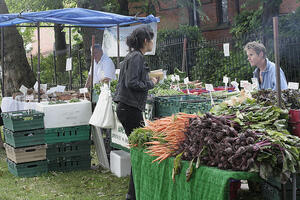”He says this will mean more small farms, more part-time farmers and more community ownership, as well as more organic and ecological production and distribution of food. Behind this and similar moves elsewhere is the reaction against the way that large multi-national chains of supermarkets have come to control what we eat and where our food comes form. Big farming, fat on EU subsidies, supplies the supermarket chains. In the process, small farmers and small shops have been squeezed out of business and food travels many kilometres from when it leaves the farm to when we eat it.
“More than 50% of our food comes from two corporations who between them are 2.5 times the size of the Scottish economy,“ says Mr Richie. He argues that this means that our food is highly processed, energy-dense and nutrient-poor. The market is in effect controlled by the producers.
The Fife Diet
Fife is a local government unit in Scotland, located just north of Edinburgh across the estuary of the River Forth. One initiative coming from this area is the Fife Diet. Its strapline is “Think global, eat local”. The aim is to make connections between food choices and the wider environment, including climate change. By setting up a local food consumer co-operative the project seeks to link food into community development and rural regeneration, themes that are central to the work of the Innovation Circle.
The Fife Diet provides a Food Map, showing the location of allotments, community gardens, “pick your own” fruit farms, as well as farmers’ markets, shops, cafes and hotels that are part of the scheme to use local sources of food. There are stickers that shops can display to promote their participation in the scheme.
There is also a carbon footprint calculator that allows you to see what the carbon footprint of your diet is. Livestock products have nearly twice the carbon footprint of plant-based foods. Refrigeration is also a large contributor to emissions. Eating locally produced food also cuts carbon emissions and The Fife Diet has issued a New Food Manifesto. It is a 20 action-point list that includes calls for a tax on plastic bags, a moratorium on supermarket expansion, farm apprenticeships and regional food mapping, to pick out just a few points.
Most fundamentally the call is for “food sovereignty”,, the ability of people to be able to control their own access to food. It is about power in the food system, and is a concept advanced by the World Development Movement. Thus the Fife Diet manifesto calls for “The Right to Grow”, raising issues of access to land. This is a controversial issue, as half of Scotland’s land is owned by just 500 people.
Wester Hailes Edible Estates
Another practical project is Wester Hailes Edible estates. Wester Hailes was the last large social housing area developed in Edinburgh. It was built in the early 1970s, but much of the high rise housing was subsequently demolished as part of a major regeneration project in the 1990s. The Edible Estates project began in July this year and is led by a health agency, using money from a Part of the context of the project is that the local council has cut back on open space maintenance, as part of on-going austerity measures. Some grassed areas have been tarmacked over and play spaces have been removed.
The project plans to set up two community food growing hubs in the estate. Each will have a community tool shed and 50 growing spaces. Thus in both schemes, 50 households will be able to grow their own fruit and vegetables in 1.2 metre by 3 metre plots. The project will also provide advice on how to grow and cook healthy food.
The project is also planning to work with local children to explore how greenspace can be managed to promote biodiversity and “natural play”. It will include a “play audit” to see where children currently play.
Smart, sustainable and inclusive growth
The EU’s strategy for recovery from the economic crisis, Europe 2020, aims for “smart, sustainable and inclusive growth”. It has shaped the 11 priority themes in the 2014-2020 round of Investment and Structural Funds. While much of the concern with innovation and “smart growth” is implicitly directed towards big cities, ICT and research, there is a case to be made that work on food networks can tick a lot of the boxes. The new round of funds looks for integrated projects, and as the above examples show, it is possible for work on food to be innovative, inclusive and contribute to environmentally sustainable development.
With the Innovation Circle due to meet in Suwalki in December and develop ideas for new projects, are their openings for ideas about how to use local food networks as a way to take forward co-operation and local economic development?
Picture: Copyright - Grievous Angel via Flickr

